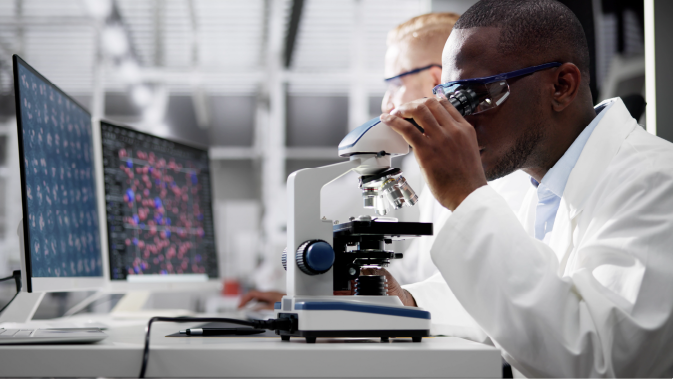Curiosity is a powerful force, always guiding us toward the unexpected. With a background deeply rooted in biomedicine, Ana’s journey took an unexpected turn when she decided to venture into the realm of software engineering, where she could apply her passion for biomedicine. It’s not just a career shift; it’s a tale woven with passion, determination, and innovation.
Let’s jump into Ana’s journey and explore the critical trends in Life Sciences, the latest technologies shaping the industry, and much more.
From biomedical researcher to product owner

For Ana Stančić, transitioning from a career in biomedical research to becoming a product owner was undoubtedly a journey with its unique challenges. She explains that this transition required a fundamental shift in mindset.
“In academia, the primary focus revolves around research – conducting experiments, data analysis, and data collection, all culminating in publications. In the world of a product owner or manager, my attention has shifted toward the business domain and, more importantly, our customers’ needs and expectations. I guess that learning how to navigate the intricate landscape of market dynamics, understanding user needs, and aligning our products with their requirements was the biggest challenge I had to overcome when transitioning from academia to the software engineering world.”
There was a substantial technical learning curve, both during her time working with software engineering and in her current role. This curve encompassed a wide array of coding languages, frameworks, and software artifacts that she needed to master.
Ana adds that adapting to an agile way of conducting tasks posed another challenge.
“In scientific research, the pace is often more measured, with projects or topics extending over longer periods. While research progresses slowly, publications are released gradually. In contrast, agile methodologies introduce a dynamic environment with many iterations and meetings. This transition pushed me to learn how to swim in these fast-moving waters.”
Legacy technology: An obstacle to digital ambitions
Ana believes that one of the biggest challenges LabTech companies face on their digitalization journey is the legacy technology that their systems rely on.
“I’d like to illustrate this with an example from one of our current clients, a situation where the instruments in use have been in service for over half a century, which is a quite common case, especially in developing countries. Understandably, we don’t expect our clients to continuously maintain and update these ancient devices. However, the task at hand is to build software instruments that can endure for several decades. We are actively working on this, but the legacy aspects bring their own set of challenges.”
In the realm of legacy systems, Ana emphasizes two major issues.
“Firstly, there is a lack of standard data formats, and standardized interfaces are often non-existent. These significantly impede integration efforts with new digital solutions that could enhance functionality.”
The second critical concern relates to security and compliance risks.
“As we know, the regulations in the laboratory technology and medical technology fields have seen considerable evolution and updates in recent years. As a result, some of these older solutions may not be compliant with these newer regulations, and the same applies to security protocols; many of these solutions were not originally designed to align with industry standards, which presents a significant challenge in the modern context.”
Ana emphasizes that, from a data perspective, there is also an issue of data silos.
“In a newly digitalized environment or solution, interoperability takes center stage. However, information is locked within isolated applications or databases, which poses a significant obstacle to achieving this interoperability. You would have to change the entire system as well as the way you access data that is trapped.”
Cost considerations also play a crucial role. Businesses must evaluate the financial implications of upgrading, migrating, or replacing these legacy systems. This process includes finding individuals with the expertise to maintain or facilitate the migration of these systems.
“Fortunately, the strength of our field lies in its diverse pool of talented individuals with a wide range of skills. This allows us to provide robust solutions to our clients, addressing these challenges head-on.”
When biomedicine meets software engineering
As much as the two concepts may differ, there are aspects of Ana’s biomedicine background that she finds particularly advantageous in software engineering. In her view, lab automation is one of the aspects worth considering.
“Many scientists contend with daily, repetitive tasks. As a cell culture scientist, one of the tasks I was mainly focused on was cell culture maintenance, which can become monotonous. I believe that automation technologies, including robotic systems for sample handling and preparation, present a promising frontier for innovation in streamlining these processes and building the true digital lab of tomorrow.”
IoT and connectivity also play a vital role in the scientific landscape and in building IoT-powered labs of the future. Remote monitoring of instruments and results obviates the need for physical proximity, enhancing efficiency.
“Rather than idly waiting for experiments to unfold, with IoT, scientists can now employ remote applications to monitor, control, and respond promptly. This significantly saves time, allowing them to focus on things that matter. The ultimate goal is to avoid wasting time on tasks that can be automated. Innovations in AI, automation, and connectivity offer significant solutions to achieve this objective.”
Staying competitive amid tech advances
The generation and analysis of vast datasets require adaptations in how we store, manage, and utilize this information, a priority for every life science company.
Ana believes that it’s imperative for Life Science companies to shift their focus toward data management, particularly when AI takes center stage. This extends to the realm of data management systems and laboratory management systems, both of which require adjustments to accommodate the surges in data.
“Life science companies are now tasked with the collection, storage, and interpretation of a wide array of data, ranging from clinical data to genomic studies. Also, with the continuous evolution of regulations and security protocols, they must remain vigilant about security and compliance risks.”
In this unique intersection of Labtech, Life Sciences, and technology, Ana highlights the challenge of finding and retaining skilled personnel.
“Discovering individuals with a perfect blend of scientific and technical expertise is a formidable task. Even once such talent is found, retaining them can be an even greater challenge.”
Mastering Life Science product delivery
To illustrate the challenges Ana and her team face in their work, she tells a story of a product launch and an issue they encountered. The client needed a crucial component for the instrument and supplier responsible for it was facing delays. As a result, the assembly line came to a halt, impacting the workers who were crucial in putting together the hardware components.
The HTEC team wanted to ensure that the software development ran smoothly and that everything was ready for the product launch at the designated time. They realized that they had to work closely with the external company that was working on the component to provide them with the information and support they needed to expedite their work.
“As we navigated this challenge, it became clear that we were no longer three separate entities but a united team working towards a common goal — to deliver the product on time. It was a true collaborative effort. We realized that their success was intertwined with ours, and by helping them, we were ultimately helping ourselves. The most important outcome was that our client received their instruments as promised, and their satisfaction was our ultimate achievement.”
Unlocking the synergy of scientists, researchers, and technology experts

In the context of a life science company, the primary focus isn’t always on facilitating collaboration. It’s more about developing and introducing new products to the market. However, Ana points out that various roles, including scientists, researchers, and technology experts, inevitably need to collaborate.
“I’ve had the privilege of working in interdisciplinary teams before, and I’ve found this incredibly beneficial. The real magic happens when you have projects that bring people with varying opinions and backgrounds together. This can lead to diverse approaches, even though they’re all addressing the same issue. If these individuals possess knowledge in multiple areas or domains, it becomes significantly easier for them to envision the product’s direction, how it fits in the current market landscape, and how emerging technologies can complement the product’s vision.”
In Ana’s opinion, what a company can do is actively nurture and encourage this kind of collaboration among individuals with different roles and backgrounds.
“Creating an environment where these teams can thrive is key. Fostering collaboration and synergy between different roles and backgrounds can be a game-changer.”
Scientific endeavors: Key trends transforming Life Sciences industry
What emerging trends and disruptive technologies are impacting the Life Sciences industry, and how are companies preparing for these changes?
As a professional with a deep understanding of both biomedicine and software engineering, Ana reflects on the specific innovations or advancements she believes will have the most transformative potential in LabTech and instrumentation.
AI is taking the spotlight
AI is a transformative force that impacts various domains and fields. This is especially evident in lab technology and life sciences, where the copious amounts of data have always been a significant facet.
“AI takes center stage. AI and machine learning algorithms play a pivotal role in expediting data analysis, enabling a deeper focus on the most relevant information, which is essential for scientists seeking truth in their datasets. It’s a significant step for the industry’s evolution.”
Precision medicine holds a promise
Speaking specifically about life science companies, precision medicine or targeted medicine is a trend that deserves a mention. While it’s not entirely new, it’s continually evolving.
“The goal here is to create tailored medical treatments for individuals, considering not only their genetic makeup but also their lifestyle, environmental factors, and more. Genetic profiling and the construction of genomic databases are at the forefront of this movement. Although we’re still exploring its full potential, it holds promise for treating genetic disorders and bringing the future of genomics into focus. It’s a field ripe for further development, and it’s exciting to see where it will take us.”
Robotics should be on everybody’s radar
Robotics is not only assisting scientists in everyday experiments but also showing potential in aiding patients. Efforts are underway to replace lost limbs and explore other medical applications. The future of robotics in medicine is a promising frontier.
Ethical concerns
Lastly, there’s the ethical aspect, which can’t be overlooked, especially in the context of new methodologies like gene editing and in vitro procedures.
“Controversies surround these technologies, and discussions continue on how they should be responsibly and ethically applied in medical and research settings. We might have the knowledge, but it doesn’t always mean we necessarily have to immediately apply it to our everyday life. Ethical considerations are paramount.”
Harnessing the collective power of brilliant minds
Ana strongly believes that HTEC Group is on its path to becoming a world leader in driving innovation in the Life Sciences industry. She reflects on the unique approaches HTEC implements to fulfill this ambition.
“What truly excites me about HTEC Group, and the very reason I’m part of this company, is the remarkable diversity of knowledge and expertise within HTEC team. It’s not only comprised of software engineers and managers; we also have domain experts. The essence of our collective success lies in teamwork, especially interdisciplinary collaboration. When individuals from different domains come together, there’s virtually no limit to what we can achieve. We encompass so much more. This is what distinguishes HTEC from being just another IT company.”
Ana holds strong ambitions for the team’s growth, envisioning a future where more domain experts join the ranks, leveraging their collective intellect to craft solutions that propel Life Science companies into the digital age. This collaborative journey is our route to future success.
Learn how we can help you build the Lab of tomorrow by contacting and connecting with Ana Stancic, Product Owner at HTEC Group, or contacting us.






